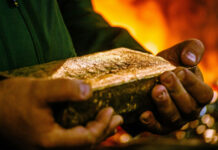
[miningmx.com] — A LOT of the conversation in the mining industry presently is whether the global economic crisis is a particularly chilling winter, or an ice age. There are no easy answers but there are some clues around.
I’m advised that the purchase of $1.28bn shares in AngloGold Ashanti by John Paulson’s Paulson & Co a week ago is one such clue.
The shares represent Anglo American’s remaining 11.3% stake in AngloGold Ashanti, and bring to completion the UK diversified firm’s long-standing strategy to get shot of its gold investment which it once held as a 50% odd-owned listed subsidiary.
What’s significant, however, is that Paulson has an outstanding track record of managing volatile markets, as supported by data from Bloomberg from which the following is derived.
Paulson recorded sixfold growth in his $30bn Credit Opportunities Fund after betting on the collapse of subprime mortgages. And in 2008, the fund gained 37% when the average performance for hedge funds over the same period was a 19% loss.
Paulson’s company has also earned about $428m since September after betting against the likes of UK banks, Lloyds Banking Group and HBOS.
“He [Paulson] made a name by being able to see the potential for extreme economic events and making bets on those that can pay off,” reported Bloomberg News, citing Michael Dubin, president of LongChamp Group, a New York firm that allocates client money to hedge funds.
If Paulson is correct again, the global economy is due for a severe and prolonged downturn making the move into gold a feasible long-term investment. And it’s not as if Paulson is just betting on AngloGold Ashanti because he likes its assets, or management’s strategy. In addition to being AngloGold’s second-largest shareholder, Paulson also happens to be the fourth-largest shareholder in Kinross Gold.
Emotionally attached to the market
Yet I still think it’s ironic that having challenged UBS on its over optimistic gold price forecast of $2,500/ounce, SA consultancy Frost and Sullivan should predict a more realistic price of $1,500/oz. For me, both are but degrees of high hopes, particularly given the fact that gold is currently trading at only $951/oz.
Haven’t we learnt from the recent metal price gyrations that extreme optimism and extreme pessimism are a single pathology, the illness being emotional attachment to the market?
Standard Bank’s Walter de Wet provided perspective in truckloads on Friday when he both made a case for gold at levels sustainably higher than $1,000/oz, and the prospect of gold falling right off.
De Wet reckons that if the European Central Bank (ECB) imposes quantitative easing, thereby following in the footsteps of the US Federal Reserve, the gold price is set for appreciation.
I now wish I’d listened more to my undergraduate colleagues, especially those writing economics. They would be able to explain with less discomfort than I that quantitative easing is where a central bank supplies new money into the market, thus creating confidence-creating liquidity, while simultaneously providing comfort for those who preserved capital by buying up government bonds.
The risk of this is inflation, and inflation is good for gold. However, the large decline in jewellery demand is “most concerning”, says De Wet.
“This decline is not only a function of the global economy in crisis, but also of the rising gold price. Should gold not become the reserve currency of choice, gold could plunge when lack of jewellery demand obliterates investment demand.”
Anglo American in the dark
But what of Anglo American of finally quitting gold, and is this another gaffe, the latest of several?
In early 2002 former Anglo CEO Tony Trahar decided to discontinue funding of the Konkola mine in Zambia, believing the copper market could not support the investment. It proved a particularly bad commodity market call, as was his view that China’s growth would ease even as it continued to accelerate.
And throughout his tenure Trahar expressed a cold distaste for gold, an apathy current CEO Cynthia Carroll seems not only to have inherited, but adopted.
Carroll is already on shaky ground, having approved the purchase of Brazilian iron ore mine MMX Mineraçao e Metalicos pretty much at the top of the market. Why didn’t she hold on to the AngloGold Ashanti shares?
In retrospect it’s easy to be damning of, undoubtedly, talented businesspersons making high-pressure decisions. But I would have thought company policy is the guiding light in such situations.
Anglo’s strategy was always predicated on its famed ability to play the “long-term game”, so it doesn’t make sense that amid a bull run for base metals Trahar and Carroll are so keen on quitting gold.
Isn’t gold the ultimate hedge, and should diversified mining houses be doing exactly that: providing shareholders with enough diversity to ride out the hard times?
I leave you with a letter published recently in Fin24.com’s sister publication, Finweek, by a reader who laments the loss of a strategy that served Anglo American so well in the past. Here’s part of what he wrote:
“In its attempt to focus, Anglo lost focus of what it was really at. In the process, they ‘threw out the baby with the bath water’ – got rid of some of their most valuable assets and, even worse, abandoned the diversified business model that made them the success they were…
“I see in Anglo a small-scale reflection of the world’s economic mess the Wall Street bankers left us in: yuppies in grey suits and fast cars abusing their power to obtain ‘neatness, focus and diversification’ in their portfolios. They dictate economic and financial rules to company boards, and manufacturing, production and sustainability rules suffer.
“They got what they wanted – but it came at a hell of a price.”











